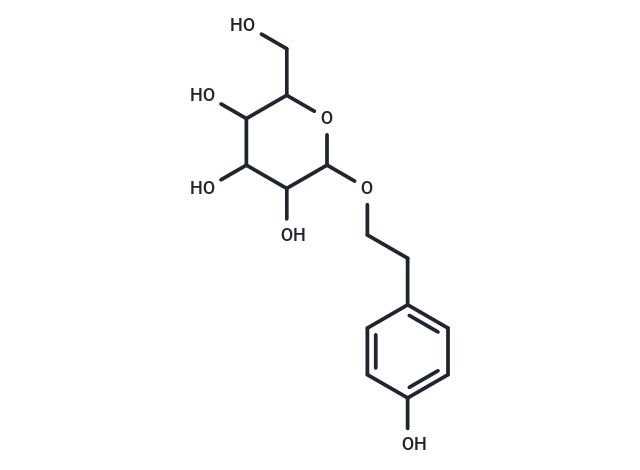Shopping Cart
- Remove All
 Your shopping cart is currently empty
Your shopping cart is currently empty

Salidroside is a bioactive phenolic glycoside compound isolated from Rhodiola rosea and is a prolyl endopeptidase inhibitor. Salidroside can alleviate cachexia symptoms in a tumor cachexia mouse model by activating mTOR signaling and protect dopaminergic neurons by enhancing PINK1/Parkin-mediated mitochondrial autophagy. Salidroside can also inhibit the growth of cancer cells by regulating the CDK4-cyclin D1 pathway to block the G1 phase and/or regulating the Cdc2-cyclin B1 pathway to block the G2 phase.

| Pack Size | Price | Availability | Quantity |
|---|---|---|---|
| 5 mg | $52 | In Stock | |
| 10 mg | $85 | In Stock | |
| 25 mg | $142 | In Stock | |
| 50 mg | $208 | In Stock | |
| 100 mg | $313 | In Stock | |
| 500 mg | $748 | In Stock | |
| 1 mL x 10 mM (in DMSO) | $64 | In Stock |
| Description | Salidroside is a bioactive phenolic glycoside compound isolated from Rhodiola rosea and is a prolyl endopeptidase inhibitor. Salidroside can alleviate cachexia symptoms in a tumor cachexia mouse model by activating mTOR signaling and protect dopaminergic neurons by enhancing PINK1/Parkin-mediated mitochondrial autophagy. Salidroside can also inhibit the growth of cancer cells by regulating the CDK4-cyclin D1 pathway to block the G1 phase and/or regulating the Cdc2-cyclin B1 pathway to block the G2 phase. |
| In vitro | METHODS: Min6 cells were co-treated with salidroside (Rhodioloside) (50 μM, 3 days), glucose or H2O2, and the changes in protein levels in β cells were detected by western blot. RESULTS Salidroside downregulated the expression of NOX2 and inhibited the subsequent activation of JNK and caspase 3, thereby preventing β cell death. [4] METHODS: SH-SY5Y cells were treated with Salidroside (Rhodioloside) (25-100 μM, 24 hours) and then exposed to MPP+ (500 μM, 24 hours). Cell viability was determined by MTT assay, cell apoptosis was analyzed by flow cytometry, and cell morphology was evaluated by Hoechst staining. RESULTS Salidroside concentration-dependently prevented the decrease in cell viability induced by MPP+; Salidroside concentration-dependently significantly reduced the number of MPP+-treated annexin V/PI-stained cells; in Hoechst staining, Salidroside significantly inhibited the MPP+-induced increase in chromatin condensation, hyperfluorescence, and nuclear fragmentation in SH-SY5Y cells. [5] METHODS: siDJ-1 transfected H-SY5Y cells were treated with Salidroside (25-100 μM, 24 hours), and then treated with MPP+ (500 μM, 24 hours). , the mRNA expression of DJ-1, Nrf2, GCLc, SOD1 and SOD2 was determined and statistically analyzed. RESULTS Silencing of DJ-1 significantly inhibited the Salidroside-induced increase in mRNA and protein levels (DJ-1, Nrf2, GCLc, SOD1 and SOD2) in MPP+-treated SH-SY5Y cells; silencing DJ-1 also significantly Significantly inhibited the Salidroside-induced decrease in ROS levels and increase in GSH levels in MPP+-treated cells. [5] |
| In vivo | METHODS: Salidroside (Rhodioloside) (100 mg, oral, once a day. 5 weeks) was used to treat db/db mice after 10 weeks of HFD, and its effect on db/db mice with prediabetes at 4 weeks was observed; after 5 weeks of treatment , conduct OGTT experiment RESULTS Salidroside could not significantly alleviate the elevated blood glucose in db/db mice within the first 15 days; Salidroside protected db/db mice from severe hyperglycemia after 21 days of treatment; Salidroside-treated db/db mice were less Rats' tolerance to glucose was significantly improved. [4] |
| Alias | Rhodioloside |
| Molecular Weight | 300.3 |
| Formula | C14H20O7 |
| Cas No. | 10338-51-9 |
| Smiles | OCC1OC(OCCc2ccc(O)cc2)C(O)C(O)C1O |
| Relative Density. | 1.46 g/cm3 (Predicted) |
| Storage | Powder: -20°C for 3 years | In solvent: -80°C for 1 year | Shipping with blue ice. | ||||||||||||||||||||||||||||||||||||||||
| Solubility Information | DMSO: 55 mg/mL (183.15 mM), Sonication is recommended. Ethanol: 4 mg/mL (13.32 mM), Sonication is recommended. H2O: 55 mg/mL (183.15 mM), Sonication is recommended. | ||||||||||||||||||||||||||||||||||||||||
Solution Preparation Table | |||||||||||||||||||||||||||||||||||||||||
Ethanol/DMSO/H2O
DMSO/H2O
| |||||||||||||||||||||||||||||||||||||||||

Copyright © 2015-2025 TargetMol Chemicals Inc. All Rights Reserved.